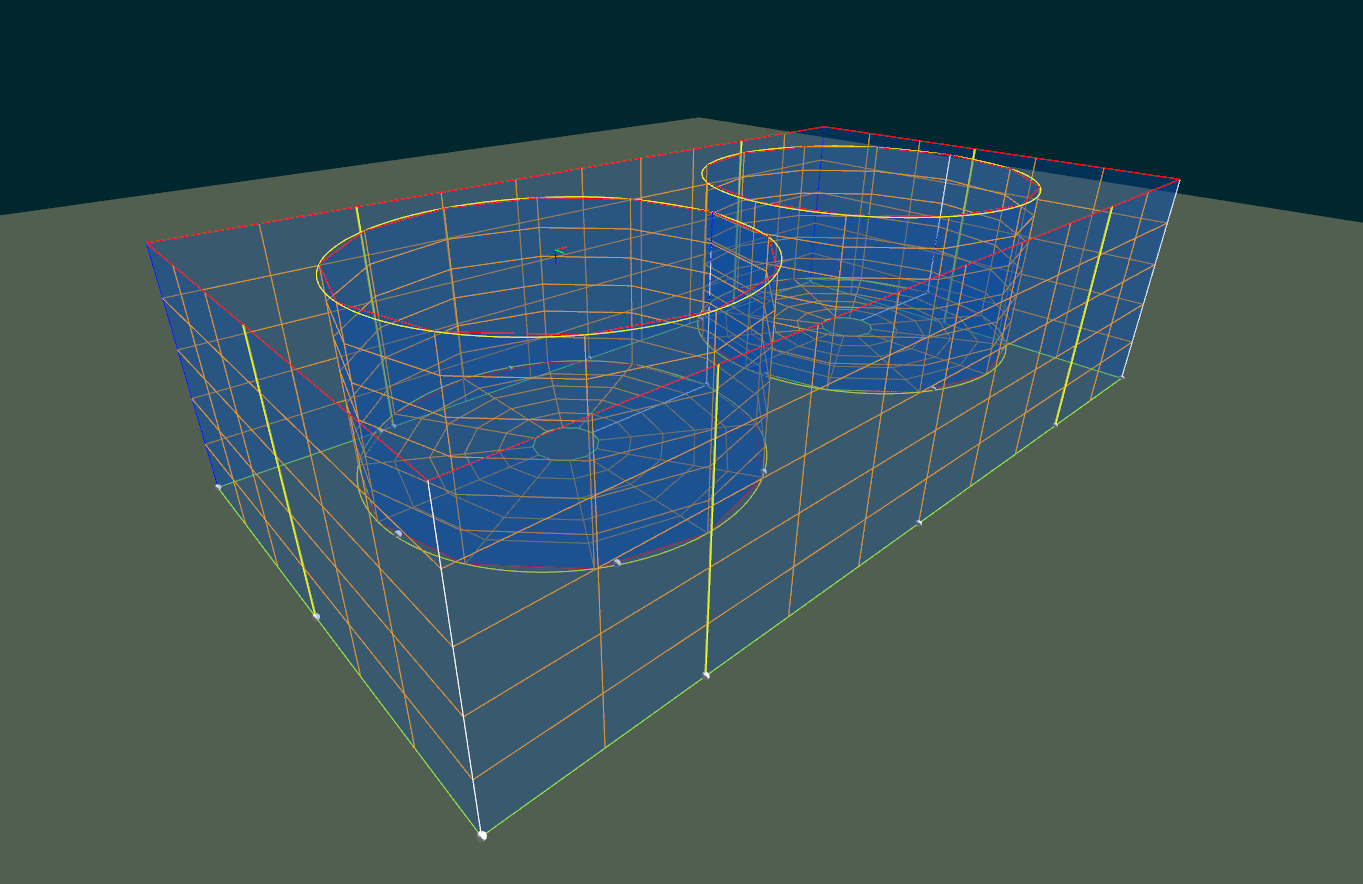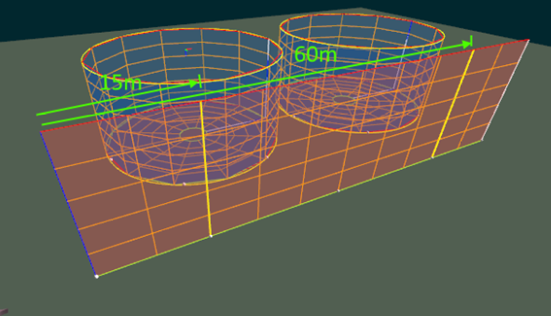59. Net extCable feature
The identification tag for this tutorial is PDS-ACJ. Pregenerated input files for this tutorial are found in the folder named PDS-ACJ in the provided tutorial input files.
59.1. Tutorial overview
This tutorial covers:
- Net arrays
- Net integrated rib lines

Fig. 59.1 Net integrated rib lines
59.2. Create a predator net panel
Note
- Integrated rib lines in nets significantly reduce the number of DObjects and connections required, as cable DObjects are not required to be created for netting rib lines.
- Integrated rib lines will be added to a basic predator net, which will be added to the Cylindrical net cage array tutorial.
- Create a copy of the input folder for the Cylindrical net cage array tutorial.
Note
- If the Cylindrical net cage array tutorial has not been completed, the required input files can be downloaded here .
- Create a new net DObject called PredatorNet_1.
- Set node (0,0)’s position to (-20,20,0) m.
- Set node (0,N)’s position to (55,20,0) m.
- Set node (M,0)’s position to (-20,20,20) m.
- Set node (M,N)’s position to (55,20,20) m.
- Define the number of elements between node (0,0) and node (0,N) to be 10.
- Define the number of elements between node (0,0) and node (M,0) to be 5.
- Set edge 0 to be static with
$Edge0Static 1in the PredatorNet_1 input file.
Note
- Once the net is created the rib lines can be added as an extra cable feature.
- Add 4 longitudinal rib lines by adding the following lines into the net input file:
$ExtCableLongitudinal segment0 0,$ExtCableLongitudinal segment0 15,$ExtCableLongitudinal segment0 60, and$ExtCableLongitudinal segment0 75.
Note
- The ExtCables on the edges are not shown in the visualizer in order to preserve the edge color definitions.
- To model the lateral rib lines, the
$ExtCableTransversecan be used in a similar fashion. - Rib lines are commonly used to support clump weights placed at the bottom of the net.
- Add a 0.5 m diameter and 2400 kg/m3 density spherical extmass named clump to the bottom of each ribline.
Note
- The PredatorNet_1 input file should look like the following:
// Boundary constraints
$Node00Static 0
$NodeM0Static 0
$Node0NStatic 0
$NodeMNStatic 0
$Edge0Static 1
$Edge1Static 0
$Edge2Static 0
$Edge3Static 0
$Edge2Ring 0
$Edge0Ring 0
// Hydrodynamic
$FluidCoefficientReData reynoldsDependentNetDragData
// Mechanical
$NetPanelProperties dNetPanel
$ExtMass clump 0 20
$ExtMass clump 15 20
$ExtMass clump 37.5 20
$ExtMass clump 60 20
$ExtMass clump 75 20
$ExtCableLongitudinal segment0 0
$ExtCableLongitudinal segment0 15
$ExtCableLongitudinal segment0 60
$ExtCableLongitudinal segment0 75

Fig. 59.2 Longitudinal ExtCable example
59.3. Add the rest of the predator cage
- Duplicate PredatorNet_1 with a -40 m offset in the Y direction.
- Rename the duplicate net as PredatorNet_2.
- Create a new net DObject called PredatorNet_3.
- Set node (0,0)’s position to (-20,-20,0) m.
- Set node (0,N)’s position to (-20,20,0) m.
- Set node (M,0)’s position to (-20,-20,20) m.
- Set node (M,N)’s position to (-20,20,20) m.
- Define the number of elements between node (0,0) and node (0,N) to be 6.
- Define the number of elements between node (0,0) and node (M,0) to be 5.
- Add a rib line onto PredatorNet_3 using
$ExtCableLongitudinal segment0 20. - Set edge 0 to be static with
$Edge0Static 1in the PredatorNet_3 input file.
// Boundary constraints
$Node00Static 0
$NodeM0Static 0
$Node0NStatic 0
$NodeMNStatic 0
$Edge0Static 1
$Edge1Static 0
$Edge2Static 0
$Edge3Static 0
$Edge2Ring 0
$Edge0Ring 0
// Hydrodynamic
$FluidCoefficientReData reynoldsDependentNetDragData
// Mechanical
$NetPanelProperties dNetPanel
$ExtMass clump 20 20
$ExtCableLongitudinal segment0 20
- Duplicate PredatorNet_3 with a 75 m offset in the X direction.
- Rename the duplicate net PredatorNet_4.
- Ensure that all nets have its edge 0 set to static.
59.4. Connect the predator cage
- Add 4 edge connections between each net to join them together.
Note
- Additional clump weights and rib lines can be added at this time if you desire.
- Run the simulation and view the results.